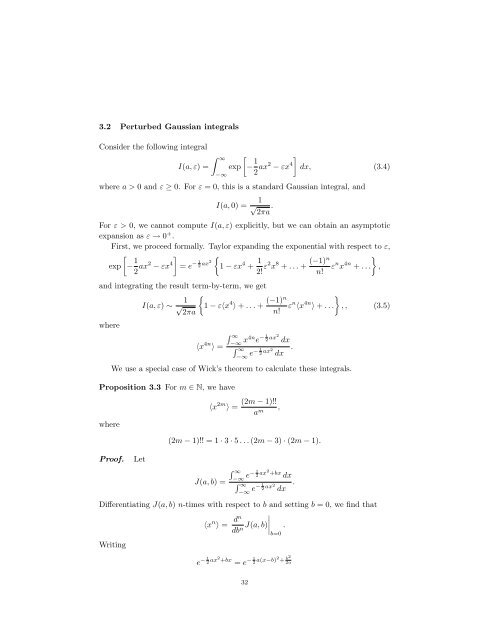Asymptotic Analysis and Singular Perturbation Theory
Asymptotic Analysis and Singular Perturbation Theory
Asymptotic Analysis and Singular Perturbation Theory
You also want an ePaper? Increase the reach of your titles
YUMPU automatically turns print PDFs into web optimized ePapers that Google loves.
3.2 Perturbed Gaussian integrals<br />
Consider the following integral<br />
I(a, ε) =<br />
∞<br />
−∞<br />
<br />
exp − 1<br />
2 ax2 − εx 4<br />
<br />
dx, (3.4)<br />
where a > 0 <strong>and</strong> ε ≥ 0. For ε = 0, this is a st<strong>and</strong>ard Gaussian integral, <strong>and</strong><br />
I(a, 0) = 1<br />
√ 2πa .<br />
For ε > 0, we cannot compute I(a, ε) explicitly, but we can obtain an asymptotic<br />
expansion as ε → 0 + .<br />
First, we proceed formally. Taylor exp<strong>and</strong>ing the exponential with respect to ε,<br />
<br />
exp − 1<br />
2 ax2 − εx 4<br />
<br />
1 −<br />
= e 2 ax2<br />
<br />
1 − εx 4 + 1<br />
2! ε2x 8 + . . . + (−1)n<br />
ε<br />
n!<br />
n x 4n <br />
+ . . . ,<br />
<strong>and</strong> integrating the result term-by-term, we get<br />
I(a, ε) ∼ 1<br />
<br />
√<br />
2πa<br />
where<br />
1 − ε〈x 4 〉 + . . . + (−1)n<br />
ε<br />
n!<br />
n 〈x 4n 〉 + . . .<br />
〈x 4n 〉 =<br />
∞<br />
−∞ x4n 1 − e 2 ax2<br />
∞ 1<br />
e− 2<br />
−∞ ax2<br />
dx<br />
dx .<br />
We use a special case of Wick’s theorem to calculate these integrals.<br />
Proposition 3.3 For m ∈ N, we have<br />
where<br />
Proof. Let<br />
〈x 2m 〉 =<br />
(2m − 1)!!<br />
am ,<br />
(2m − 1)!! = 1 · 3 · 5 . . . (2m − 3) · (2m − 1).<br />
J(a, b) =<br />
∞ 1<br />
e− 2<br />
−∞ ax2 +bx dx<br />
∞ 1<br />
e− 2<br />
−∞ ax2 dx .<br />
<br />
, , (3.5)<br />
Differentiating J(a, b) n-times with respect to b <strong>and</strong> setting b = 0, we find that<br />
〈x n 〉 = dn<br />
<br />
<br />
J(a, b) .<br />
dbn Writing<br />
b=0<br />
1 −<br />
e 2 ax2 +bx −<br />
= e 1<br />
2 a(x−b)2 + b2<br />
2a<br />
32
















